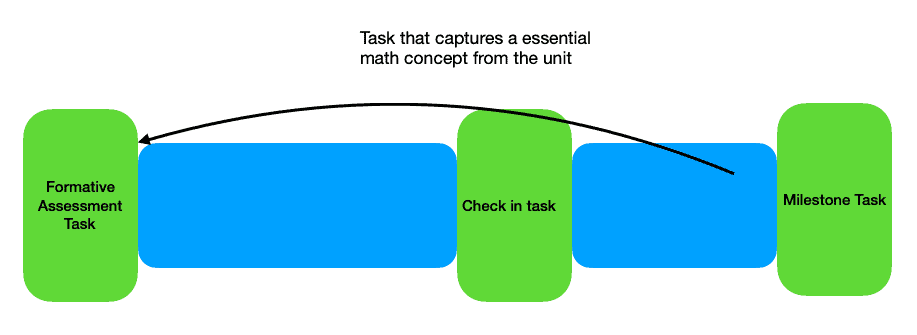The importance of formative assessment has been well established. No one would argue that it is essential to know where students are at when designing instruction. The question often becomes: “What is the best way for me to gain an understanding of what my students know and are able to do?”
In my first blog post for Peers and Pedagogy, I outlined a two-day lesson using the Three Reads Protocol and a re-engagement. Here, I want to further explore the idea I alluded to of using this structure or a similar structure as a pre-assessment for a unit of instruction.
Pre-Assessment
It is a common practice to pre-assess students on foundational ideas that are key for an upcoming unit. Typically, these assessments are filled with questions on the lower end of the depth of knowledge scale. This puts focus on a student’s ability to get answers right or wrong, not their strengths and levels of understanding.
In my experience, teachers often look at the results of these assessments and feel the need to pre-teach a lot of below grade-level skills before entering the unit. With the crunch of time and resources, many times these lessons are done with the whole class. Before you know it, you are a week into a four-week unit, and you and your students have not engaged in the grade-level content of that unit yet.
This is a very reasonable course of action that I know myself have fallen prey to. Teachers have students’ best interest in mind when engaging in this work. However, there are some unintended consequences of preceding in this way.
Unintended consequences
First, in the example above, we have used up valuable instructional time, and now we have less time for grade-level content. If we do this for each unit, we end up not giving enough time to grade-level content during a given year. At the end of the school year, the students are “more behind” and not ready for the work of the next year. This can become a vicious cycle.
Second, what is the message that this sends to kids? As mentioned in my first blog post, I really want to activate student agency whenever possible. Students might walk away with thoughts of “I must not be that smart because I don’t remember how to do stuff from last year” and “I have to be taught all the skills from previous years before I can tackle grade-level math.” Neither of these thoughts get students to the place of: “Math should make sense, and I am going to work on it until it does.”
What if, instead, we start by diving right into grade-level content on Day 1 of a unit? We can do this in a way that gives us information about how to best support students as we move through the unit. The idea I propose here is to use a task on the first day of a unit that really gets at the central idea(s) of the unit. I once heard Phil Daro, one of the three lead writers of the Common Core, put it this way: “Find a problem from the end of the chapter and pull it forward to give to the students on Day 1 of the unit.”

A grade-level task on Day 1 provides the opportunity to get right into grade-level mathematics, but it also allows teachers to assess students while they are engaged in a meaningful task. In other words, students are afforded the opportunity to learn and are not fully aware that they are being formally assessed.
Of course, you want to make sure that the task is accessible to all students.You want to have a task that is low floor/high ceiling. I start by looking at Math MilestonesTM tasks. Math MilestonesTM tasks capture grade-level mathematics and are readily accessible to students with varying degrees of prior knowledge. For example, in the example from my first blog post, I used the grade 3 Math MilestonesTM task 3:1—”There are five teams in the volleyball league. Every team has six players. How many players are in the volleyball league?” for this purpose. The students had not yet formally studied multiplication. This problem was very accessible because of the size of the numbers involved. Students could solve it using grade 2 math.
Much of my thinking on this is supported by the work of TNTP and their idea to “Accelerate Don’t Remediate.” The main concept that a grade-level task at the beginning of a unit supports is “just in time” support versus “just in case.” The first scenario I described, in which a typical pre-assessment is used and followed up with a week of remediation, is “just in case” teaching. “Just in case” the students need these skills from a prior grade level in this unit, I am going to reteach them before I start. Contrast that with: I now better understand how students are thinking about grade-level content and can support them “just in time” as we move through the unit based on this knowledge.
Launching a unit with the tasks also allows the teacher to take more of a facilitator stance during the lesson than what they are accustomed to. Since they have not taught the content of the task and they are using it as a formative assessment, it is easier for teachers to not jump in and “save” their students. In our district, we have been working on using the Launch Explore Discuss lesson framework more often as a way to activate student agency. It is much easier to get teachers into this way of teaching during these tasks at the beginning of a unit.
It is vital we find ways to get students engaged in grade-level mathematics. Using a task as a pre-assessment to a unit that captures the idea(s) central to the unit is just one way to maintain high expectations for students while learning about ways we can support them. Bringing an asset-based lens to work and seeing students’ strengths and their ability to work on problems we have not taught them how to solve is a key to our ability to accelerate their learning.


















